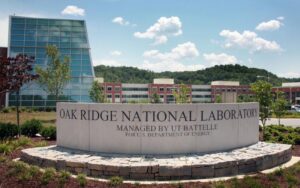The U.S. Department of Energy‘s (DOE) Oak Ridge Reservation (ORR) consists of approximately 37,000 acres of federally-owned land in Anderson and Roane Counties, Tennessee. The ORR is bounded on the north and east by the City of Oak Ridge boundary, and on the south and west by the Clinch River. The western part of the ORR boundary lies just outside the City of Oak Ridge corporate limits.
Approximately 25,000 of the ORR’s roughly 37,000 acres have remained undeveloped in a relatively natural state. Approximately 20,000 of the 25,000 acres have been designated a DOE National Environmental Research Park, an international biosphere reserve, and part of the Southern Appalachian Man and the Biosphere Cooperative.
The entire ORR was designated a CERCLA site (Superfund) by the U.S. Environmental Protection Agency (EPA) in 1989.
About 15% of the ORR is contaminated by hazardous and radioactive materials, including waste sites or remediation areas. This legacy contamination is being cleaned up in accordance with the existing Federal Facilities Agreement. The Tennessee Division of Remediation’s Oak Ridge Office oversees all environmental protection and restoration activities on the ORR.
Now, on August 11, 2022, the U.S. Department of Energy (DOE) and the State of Tennessee entered into an Agreement in Principle related to remediating and restoring contamination and natural resource damage on the DOE’s Oak Ridge Reservation.
Together, they and the other members of the trustee council are releasing a document that shares restoration and compensation plans, which was available for a 45-day public comment period from August 15 – September 28.
To address impacts from past operations on the Oak Ridge Reservation, DOE conducts environmental cleanup projects to eliminate and reduce risks to human health and the environment.
However, these efforts do not always fully restore injured natural resources or address their lost uses by the public. Through the Natural Resources Damage Assessment process, evaluations are completed to identify the extent of resource injuries, the best methods for restoring those resources, and the type and amount of restoration required.
Under the recent agreement, DOE and the State of Tennessee will establish a $42 million account for the Oak Ridge Reservation that will fund projects that will restore and protect natural resources and enhance the local environment.
Full details about the natural resource damages and how DOE will compensate for ecological and human use impacts are available in the draft document titled, “Oak Ridge Reservation Natural Resource Damage Assessment: Restoration and Compensation Determination Plan/Environmental Assessment.”
The trustee council, comprised of representatives from DOE, State of Tennessee, U.S. Fish and Wildlife Service, and Tennessee Valley Authority, is responsible for evaluating how natural resources were injured and developing a restoration program to compensate for those injuries.
The council hosted a public meeting to provide information and answer questions about the Restoration and Compensation Determination Plan and Environmental Assessment on August 31, at TownePlace Suites Oak Ridge in Oak Ridge.
DOE has previously signed agreements and provided compensation for specific impacted areas. This latest agreement addresses all remaining historical natural resource damages for the entire Oak Ridge Reservation.
A week later, on August 17, 2022, Deputy Secretary of Defense Dr. Kathleen H. Hicks and Deputy Secretary of Energy David M. Turk visited Oak Ridge National Laboratory.
“Research and education programs at Oak Ridge National Laboratory are cutting edge and teach the critical skills American workers need to stay competitive in the global marketplace,” said Deputy Secretary Hicks.
“The advanced manufacturing innovations here are already transforming defense production through major productivity, quality, and business model gains. The program also incorporates student learning opportunities that will provide the talent and creativity needed for the next era of American manufacturing,” she added.
While there, they toured Oak Ridge’s Battery Manufacturing Facility, the largest U.S. open-access battery manufacturing research and development center. The Department of Energy’s Battery Manufacturing Facility provides scientists with the ability to analyze every aspect of battery production.
Scientists use advanced computational modeling to accelerate prototyping of cell designs, to screen new battery materials, and to develop accurate lifetime predictions. Open to any U.S. battery manufacturer, material supplier, equipment manufacturer, or battery end user, the center offers the ability to integrate any component into a complete battery and analyze how well it works and how it can be improved.
Deputy Secretary Hicks and Deputy Secretary Turk also visited the Manufacturing Demonstration Facility which is home to America’s Cutting Edge (ACE), a joint effort between the Department of Defense and Department of Energy to strengthen America’s machine tool sector, which is essential for defense and clean energy production.
Since March 2020, DoD has invested $42 million (that seems to be their preferred number for everything) in ACE, a national machine tools innovation hub seeking to restore the prominence of the U.S. machine tool sector, as well as the training program run by the Institute for Advanced Composites Manufacturing Innovation (IACMI)—The Composites Institute.
Finally, they visited Frontier, the first computer to achieve exascale computation threshold. Delivered in 2021 and open for early operations in 2022, Frontier is accelerating innovation in science and technology and maintaining US leadership in high-performance computing and artificial intelligence.
Frontier users will model the entire lifespan of a nuclear reactor, uncover disease genetics, and build on recent developments in science and technology to further integrate artificial intelligence with data analytics and modeling and simulation. Frontier is part of the Oak Ridge Leadership Computing Facility, a Department of Energy Office of Science user facility located at ORNL.
The visit highlighted the importance the Biden-Harris Administration is placing on American manufacturing capabilities and building supply chain resilience.
The Biden Administration’s Bipartisan Infrastructure Law provides as much as $8.2B to solve domestic battery supply chain challenges. DoD is coordinating with Energy, State, Commerce, and others to ensure those investments are dual-use and benefit national security where possible.
Image by Clker-Free-Vector-Images from Pixabay.


